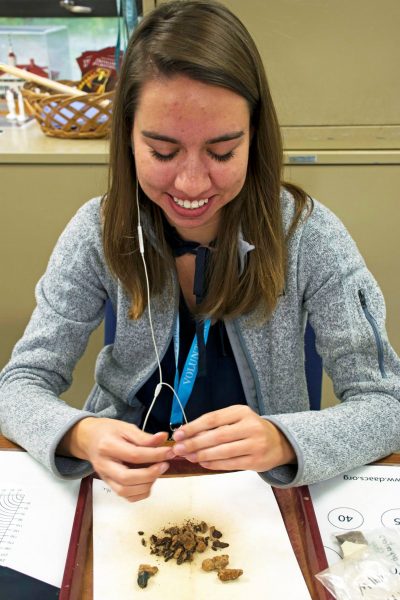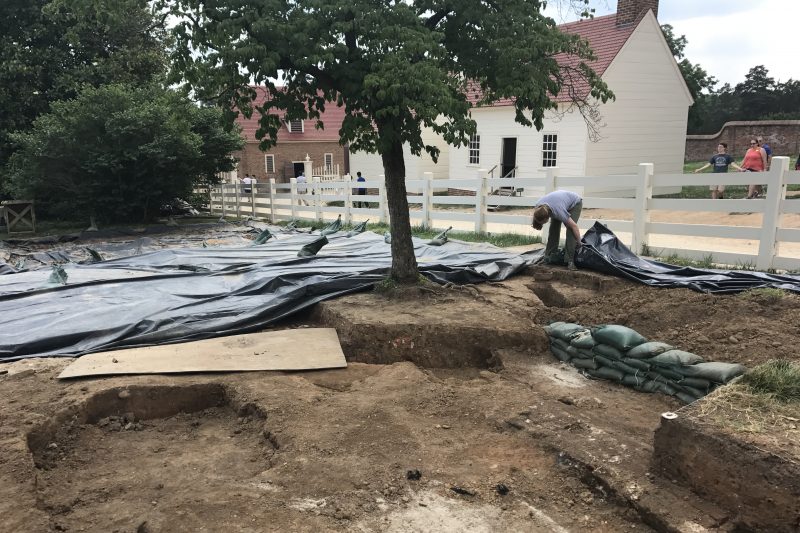Visiting George at Home Anna Milewski '18 has spent time in fields, labs, carpenter shops and seminar rooms - and it was all part of one internship at the home of George Washington.
“I am so grateful to attend an institution that always encourages stepping outside of one’s normal academic routine in the pursuit of new and exciting experiences!”
Hometown: Hudson, WI
Majors: Sociology and Anthropology; Economics
Q. Tell us a little bit about your summer opportunity.
This summer I worked as an archaeological curation intern at George Washington’s Mount Vernon.
Q. What was your favorite aspect of Mount Vernon?
I got to work at George Washington’s plantation home every single day, which was an incredible experience in and of itself when considering the historic nature of the property. Some of my favorite moments of the internship were walking on the property early in the morning before opening, when it was still on the cooler side and members of the grounds crew, collections department or architecture department were out preparing the property for that day’s visitors.
Q. What did an average day for you look like?
Every day, I went into the archaeology lab at 8 a.m. and spent the day working on my project, which involved creating a rudimentary catalog of artifacts from a site known as the Carpenter’s Shop. However, each day was different in the Historic Preservation Department. For instance, one day we volunteered with Alexandria Archaeology to help them prepare an 18th-century ship to be moved for preservation. Other days, the department’s volunteers came in and we would wash, sort, label and bag artifacts. For a few days, I had the opportunity to work in the field, screening for artifacts. There was no truly average day at Mount Vernon, as there was always someone new stopping by the archaeology lab to either learn from the staff or share information that could help our work in archaeology.
Q. What was the most rewarding part of the experience?
Working with the Historic Preservation team (which includes both the Archaeology and Architecture departments) every day was the best part of my internship. They are some of the most intelligent, passionate, welcoming and hilarious people I’ve ever worked with, and they made each day exciting and interesting!
Q. What was the biggest challenge you faced?
The learning curve at the beginning was definitely the most challenging aspect I faced. In order to be able to contribute in the lab, I first had to get up to speed on 18th-century material culture, including ceramic types, nail types and glass types (the three main artifacts I was cataloging). Not having a lot of background in colonial and early American history, I was definitely grateful to be working with Sean Devlin, curator of archaeological collections, who taught me so much and answered my endless questions.
Devlin, a W&L alum, was such a great mentor and teacher during my entire internship. He shared his vast knowledge of 18th-century material culture with me on topics such a ceramic types, 18th-century plantation life, and the theory and academic debates on archaeology.
Q. What have you learned at W&L that helped you in this endeavor, and what will you bring back to your life on campus?
Had I not taken my Spring Term course last year (Archeology Lab Methods with Professor Gaylord), I probably would never have been able to do this internship. That course introduced me to archaeology and showed me the possibilities for using archaeology to better understand the lives of those not often documented in traditional historical resources, such as the enslaved people working and living at Mount Vernon. I learned of this internship through the Sociology and Anthropology Department and was lucky to have had some background from that course coming into the internship.
Q. Has this experience impacted your studies or future plans in any way?
Although I don’t think archaeology will be a part of my long-term career goals (ultimately, I want to attend a sociology Ph.D. program and teach and do research as a professor), this experience has taught me the importance of letting your work be driven by your questions about the world around you. Much of the archaeology done at Mount Vernon is driven by research questions that are trying to understand the lives of the many people who lived on the property before, during, and after George’s residence there. Always being curious and asking questions has driven my academic career so far, and the pursuit for answers (or at least a better understanding of my research interests) is what motivates me in my career goals.
Q. Why is this kind of experience important to W&L students?
This internship was born from the liberal arts experience that W&L cherishes. I initially registered for the Archaeology Lab Methods course because it fulfilled my Lab Sciences FDR requirement. That course led me to this internship, an experience that I may never get again if I don’t go into archaeology as a career. This internship was completely different from what I did the last two summers, and I am so grateful to attend an institution that always encourages stepping outside of one’s normal academic routine in the pursuit of new and exciting experiences!
I want to add that I never could have had this experience without the generosity of the Johnson Opportunity Grant, which funded my costs during this internship.
Q. Describe your summer adventure in one word:
Historic
If you know any W&L students who would be great profile subjects, tell us about them! Nominate them for a web profile.
 Anna Milewski ’18 has spent time in fields, labs, carpenter shops, and seminar rooms – and it was all part of one internship at the home of George Washington
Anna Milewski ’18 has spent time in fields, labs, carpenter shops, and seminar rooms – and it was all part of one internship at the home of George Washington The Mount Vernon dig site
The Mount Vernon dig site
You must be logged in to post a comment.